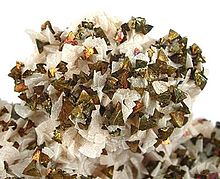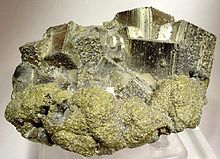- Chalcopyrite
-
Chalcopyrite 
Twinned chacopyrite crystal from the Camp Bird Mine, Ouray County, Colorado (size:5.2 x 3.6 x 2.7 cm)General Category Sulfide mineral Chemical formula CuFeS2 Strunz classification 02.CB.10a Crystal symmetry Tetragonal 42m – scalenohedral Unit cell a = 5.289 Å, c = 10.423 Å; Z = 4 Identification Molar mass 183.54 Color Brass yellow, may have iridescent purplish tarnish. Crystal habit Predominantly the disphenoid and resembles a tetrahedron, commonly massive, and sometimes botryoidal. Crystal system Tetragonal Scalenohedral 42m Twinning Penetration twins Cleavage Indistinct on {011} Fracture Irregular to uneven Tenacity Brittle Mohs scale hardness 3.5 Luster Metallic Streak Greenish black Diaphaneity Opaque Specific gravity 4.1 – 4.3 Solubility Soluble in HNO3 Other characteristics magnetic on heating References [1][2][3][4][5] Chalcopyrite (
 /ˌkælkɵˈpaɪraɪt/ kal-ko-py-ryt) is a copper iron sulfide mineral that crystallizes in the tetragonal system. It has the chemical composition CuFeS2. It has a brassy to golden yellow color and a hardness of 3.5 to 4 on the Mohs scale. Its streak is diagnostic as green tinged black.
/ˌkælkɵˈpaɪraɪt/ kal-ko-py-ryt) is a copper iron sulfide mineral that crystallizes in the tetragonal system. It has the chemical composition CuFeS2. It has a brassy to golden yellow color and a hardness of 3.5 to 4 on the Mohs scale. Its streak is diagnostic as green tinged black.On exposure to air, chalcopyrite oxidises to a variety of oxides, hydroxides and sulfates. Associated copper minerals include the sulfides bornite (Cu5FeS4), chalcocite (Cu2S), covellite (CuS), digenite (Cu9S5); carbonates such as malachite and azurite, and rarely oxides such as cuprite (Cu2O). Chalcopyrite is rarely found in association with native copper.
Contents
Identification
Chalcopyrite is often confused with pyrite, although the latter has a cubic and not a tetragonal crystal system. Further, chalcopyrite is often massive, rarely crystalline, and less brittle. Chalcopyrite is also a darker yellow in color, with a greenish tinge and diagnostic greasy luster.
Due to its color and high copper content, chalcopyrite has often been referred to as "yellow copper" or "fool's gold".
Chemistry
Natural chalcopyrite has no solid solution series with any other sulfide minerals. There is limited substitution of Zn with Cu despite chalcopyrite having the same crystal structure as sphalerite.
However, it is often contaminated by a variety of other trace elements such as Co, Ni, Mn, Zn and Sn substituting for Cu and Fe. Se, Fe and As substitute for sulfur, and trace amounts of Ag, Au, Pt, Pd, Pb, V, Cr, In, Al and Sb are reported.
It is likely many of these elements are present in finely intergrown minerals within the chalcopyrite crystal, for instance lamellae of arsenopyrite representing As, molybdenite representing Mo, etc.
Paragenesis
Chalcopyrite is present with many ore bearing environments via a variety of ore forming processes.
Chalcopyrite is present in volcanogenic massive sulfide ore deposits and sedimentary exhalative deposits, formed by deposition of copper during hydrothermal circulation. Chalcopyrite is concentrated in this environment via fluid transport.
Porphyry copper ore deposits are formed by concentration of copper within a granite stock during the ascent and crystallisation of a magma. Chalcopyrite in this environment is produced by concentration within a magma system.
Chalcopyrite is an accessory mineral in Kambalda type komatiitic nickel ore deposits, formed from an immiscible sulfide liquid in sulfur-saturated ultramafic lavas. In this environment chalcopyrite is formed by a sulfide liquid stripping copper from an immiscible silicate liquid.
Occurrence
Chalcopyrite is the most important copper ore. Chalcopyrite ore occurs in a variety of ore types, from huge masses as at Timmins, Ontario, to irregular veins and disseminations associated with granitic to dioritic intrusives as in the porphyry copper deposits of Broken Hill, the American cordillera and the Andes. The largest deposit of nearly pure chalcopyrite ever discovered in Canada was at the southern end of the Temagami greenstone belt where Copperfields Mine extracted the high-grade copper.[6]
Chalcopyrite is present in the supergiant Olympic Dam Cu-Au-U deposit in South Australia.
Chalcopyrite may also be found in coal seams associated with pyrite nodules, and as disseminations in carbonate sedimentary rocks.
Structure
Crystallographically the structure of chalcopyrite is closely related to that of zinc blende ZnS (sphalerite). The unit cell is twice as large, reflecting an alternation of Cu+ and Fe3+ ions replacing Zn2+ ions in adjacent cells. In contrast to the pyrite structure chalcopyrite has single S2- sulfide anions rather than disulfide pairs. Another difference is that the iron cation is not diamagnetic low spin Fe(II) as in pyrite.
See also
- Classification of minerals
- List of minerals
- Kesterite
References
- ^ Klein, Cornelis and Cornelius S. Hurlbut, Jr., Manual of Mineralogy, Wiley, 20th ed., 1985, pp. 277 – 278 ISBN 0-471-80580-7
- ^ Palache, C., H. Berman, and C. Frondel (1944) Dana’s system of mineralogy, (7th edition), v. I, 219–224
- ^ http://www.mindat.org/min-955.html mindat.org
- ^ http://webmineral.com/data/Chalcopyrite.shtml Webmineral.com
- ^ Handbook of Mineralogy
- ^ Barnes, Michael (2008). More Than Free Gold. Renfrew, Ontario: General Store Publishing House. p. 31. ISBN 978-1-897113-90-5.
Ores Acanthite (silver) · Chalcopyrite (copper) · Chalcocite (copper) · Cinnabar (mercury) · Galena (lead) · Pentlandite (nickel) · Sphalerite (zinc)OtherOre deposit types Banded iron formation · Carbonate hosted lead zinc ore deposits · Heavy mineral sands · Iron oxide copper gold · Kambalda type komatiitic nickel ore deposits · Lateritic nickel · Magmatic nickel-copper-iron-PGE deposits · Porphyry copper · Sedimentary exhalative deposits · Volcanogenic massive sulfideCategories:- Copper minerals
- Sulfide minerals
- Iron minerals
- Tetragonal minerals
Wikimedia Foundation. 2010.



